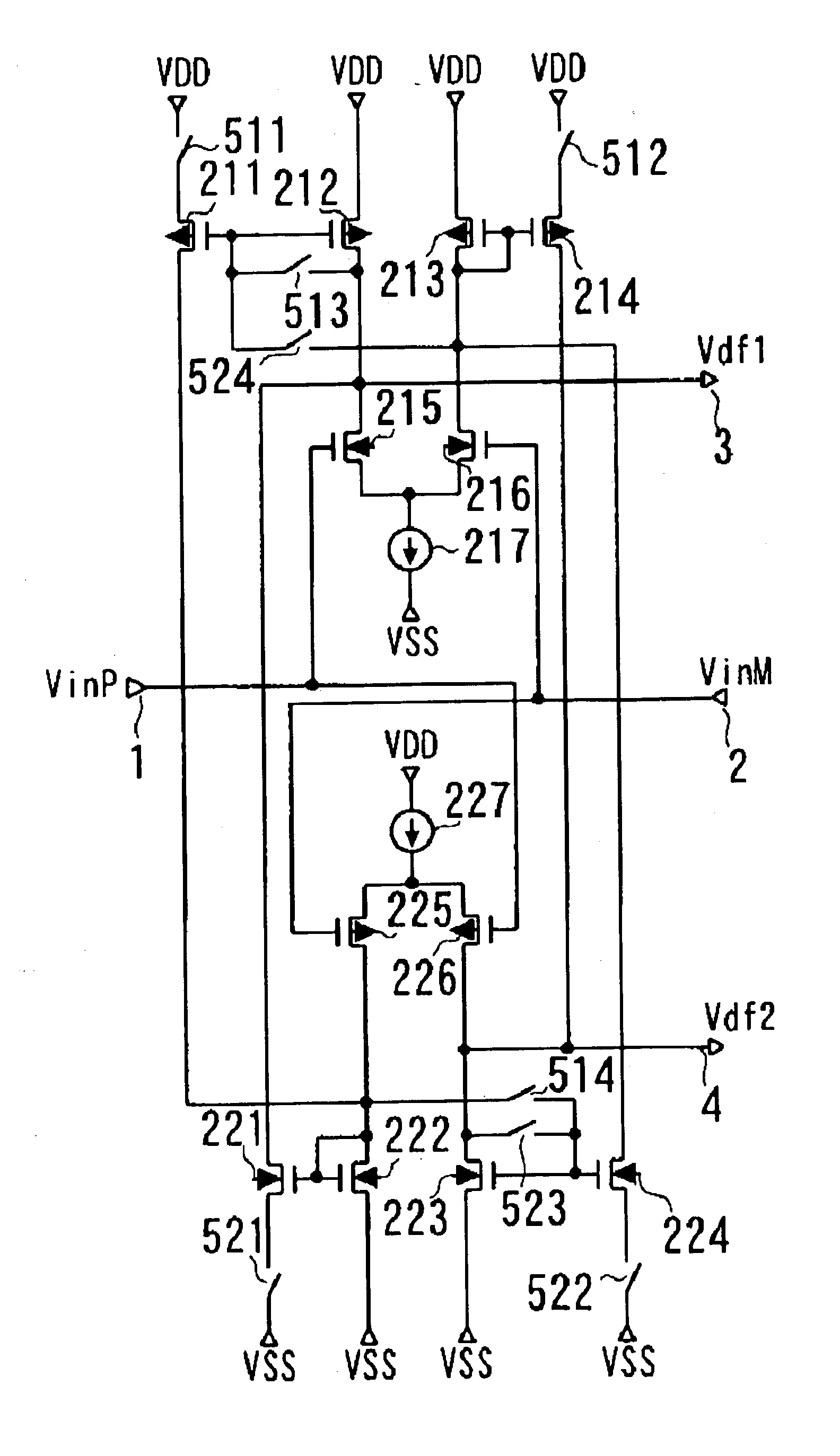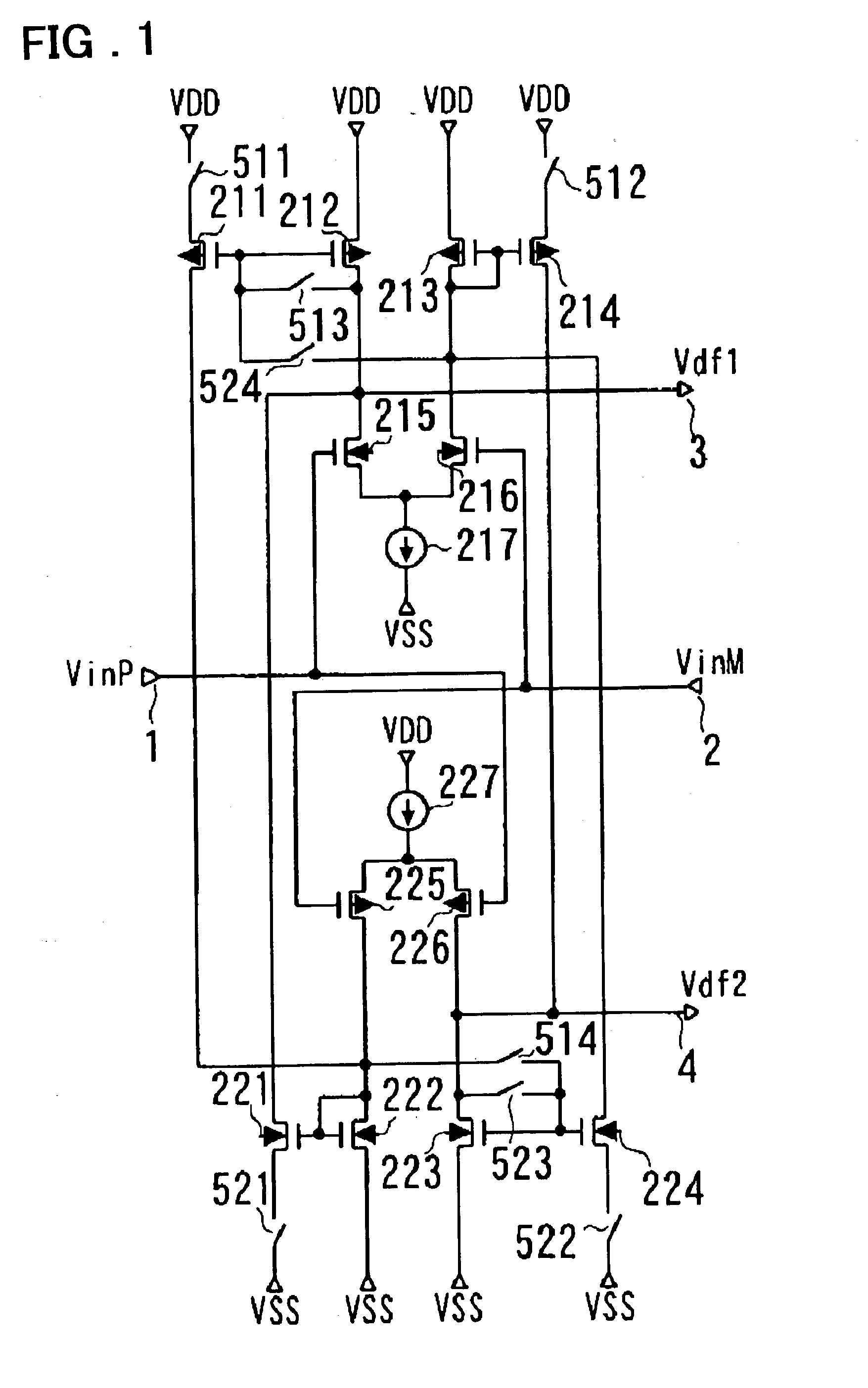Differential circuit, amplifier circuit, and display device using the amplifier circuit
- Summary
- Abstract
- Description
- Claims
- Application Information
AI Technical Summary
Benefits of technology
Problems solved by technology
Method used
Image
Examples
first embodiment
[0163] In order to describe the mode for practicing the present invention in further detail, embodiments of the present invention will be described with reference to drawings. FIG. 1 is a diagram showing the present invention.
[0164] Referring to FIG. 1, a differential circuit according to this embodiment includes n-channel transistors 215 and 216, p-channel transistors 211, 212, 213 and 214, a constant-current source 217 and switches 511, 512, 513 and 524 and outputs a first differential output Vdf1 from a drain of the n-channel transistor 215.
[0165] Sources of the n-channel transistors 215 and 216 are commonly connected to the constant-current source 217, and the n-channel transistors 215 and 216 receive input voltages VinP and VinM at their gates, respectively to form a differential pair. The source of the p-channel transistor 212 is connected to a power supply VDD, and a drain of the p-channel transistor 212 is connected to the drain of the n-channel transistor 215. The source of...
third embodiment
[0198] Next, other embodiment of the present invention will be described. FIG. 6 shows a configuration according to the present invention. FIG. 6 shows the configuration of an amplifier circuit configured by using the differential circuit in FIG. 1. That is, a differential circuit in FIG. 6 including the n-channel differential pair (215, 216), p-channel differential pair (225, 226), p-channel transistors (211, 212, 213, 214), n-channel transistors (221, 222, 223, 224), constant-current sources 217 and 227, and connection changeover means (the switches 511 to 514, 521 to 524) is the same as the differential circuit shown in FIG. 1. FIG. 7 is a table showing an example of methods of controlling the amplifier circuit in FIG. 6.
[0199] Referring to FIG. 6, this amplifier circuit is a feedback-type amplifier circuit that includes amplification stages 310 and 320 that operate in response to the outputs Vdf1 and Vdf2 of the differential circuit shown in FIG. 1, respectively. Referring to FI...
fourth embodiment
[0207] Other embodiment of the present invention will also be described. FIG. 8 shows a configuration according to the present invention. FIG. 8 shows the configuration of an amplifier circuit configured by using the differential circuit in FIG. 1. That is, referring to FIG. 8, an amplifier circuit 210 composed by the n-channel differential pair (215, 216), p-channel differential pair (225, 226), p-channel transistors (211, 212, 213, and 214), n-channel transistors (221, 222, 223, and 224), constant-current sources 217 and 227, and connection changeover means (the switches 511 to 514, 521 to 524) is the same as the differential circuit shown in FIG. 1.
[0208] The amplification stage 310 for charging includes a p-channel transistor 311, a switch 553, and a constant-current source 313. The source of the p-channel transistor 311 is connected to the high-potential power supply VDD, the drain of the p-channel transistor 311 is connected to the output terminal 2, and the gate of the p-chan...
PUM
 Login to View More
Login to View More Abstract
Description
Claims
Application Information
 Login to View More
Login to View More - R&D
- Intellectual Property
- Life Sciences
- Materials
- Tech Scout
- Unparalleled Data Quality
- Higher Quality Content
- 60% Fewer Hallucinations
Browse by: Latest US Patents, China's latest patents, Technical Efficacy Thesaurus, Application Domain, Technology Topic, Popular Technical Reports.
© 2025 PatSnap. All rights reserved.Legal|Privacy policy|Modern Slavery Act Transparency Statement|Sitemap|About US| Contact US: help@patsnap.com



